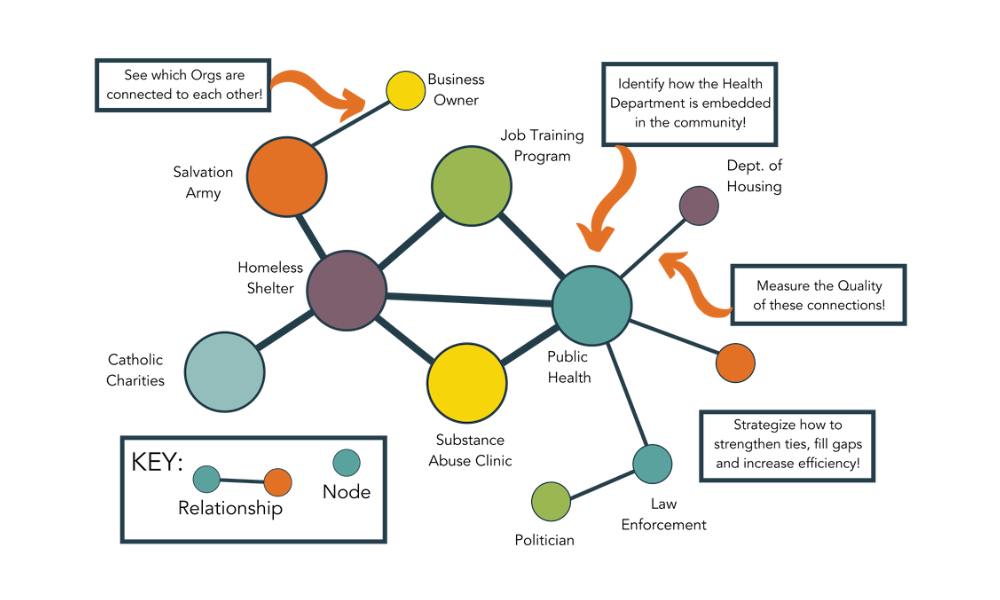In today’s interconnected world, understanding the intricate web of relationships within communities, organizations, and systems is more crucial than ever. Social Network Analysis (SNA) provides a powerful lens to examine these connections, revealing valuable insights that can drive strategic decisions and foster meaningful collaboration. But what can social network analysis tell you?
In this article, let’s delve into the transformative potential of this analytical approach.
What is Social Network Analysis?
Social Network Analysis (SNA) is a powerful method for examining the relationships and interactions within a network of individuals, organizations, or other entities. By mapping these connections, SNA provides a visual and quantitative analysis of how entities are interconnected, allowing for a deeper understanding of the network’s structure and dynamics.
SNA originated from sociology and has evolved into a multidisciplinary tool utilized in various fields such as public health, business, education, and community development. It leverages the principles of network science to reveal hidden patterns, identify key influencers, and understand the flow of information and resources within a network. This analytical approach goes beyond traditional data analysis by focusing on the relationships themselves rather than just the attributes of the entities involved.
At its core, SNA involves collecting data on the connections between entities and analyzing this data to generate network maps and metrics. These maps and metrics provide valuable insights that can inform strategic decisions, enhance collaboration, and ultimately lead to more effective and impactful outcomes.

What Can Social Network Analysis Tell You?
Now that we have a foundational understanding of what SNA is, let’s explore what it can actually tell you and how these insights can be applied in various contexts.
1. Identifying Key Players and Influencers
One of the primary benefits of SNA is its ability to pinpoint key individuals or entities within a network. By mapping out relationships, SNA can highlight who holds significant influence, who acts as a bridge between different groups, and who may be isolated or peripheral. This insight is invaluable for organizations aiming to leverage their most influential members to drive initiatives, foster innovation, or facilitate communication across different sectors.

Get our monthly newsletter with resources for cross-sector collaboration, VNL recommended reading, and upcoming opportunities for engaged in the “network way of working.”
2. Visualizing Network Structure and Dynamics
SNA offers a visual representation of the network’s structure, allowing you to see the big picture of how entities are interconnected. This visualization can reveal patterns such as clusters of tightly-knit groups, the presence of sub-networks, and overall network cohesion. Understanding these dynamics can help in strategizing interventions, improving resource allocation, and enhancing overall network performance.
3. Assessing Relationship Quality and Evolution
Beyond just identifying connections, SNA can evaluate the quality of these relationships. Are the interactions collaborative and trusting, or are they marked by competition and distrust? Tracking these metrics over time allows organizations to monitor the health of their networks and make informed decisions to strengthen weak ties or resolve conflicts, ultimately fostering a more robust and resilient community.
4. Supporting Strategic Planning and Decision-Making
With its comprehensive insights, SNA supports high-level strategic planning. Organizations can use SNA data to align their goals with the network’s strengths and address its weaknesses. For instance, public health departments might use SNA to tailor interventions for maximum impact, while foundations could strategically allocate grants to foster collaboration among grantees. This data-driven approach ensures that strategies are not only well-informed but also effective in achieving desired outcomes.

5. Enhancing Community Engagement and Collaboration
SNA can significantly enhance community engagement by making visible the often-invisible connections within a community. By understanding how individuals and groups interact, organizations can design more targeted and effective engagement strategies. This fosters a sense of belonging and collaboration, driving social improvements and community development.

6. Measuring Impact and Telling Your Network’s Story
Every group of partners has a story about their work and its impact on people’s lives. SNA helps create a narrative by visualizing how partners come together, build new ties, and collaborate over time to make a difference. This storytelling capability not only showcases achievements but also builds transparency and trust within the community.
Applying SNA with PARTNER CPRM
At Visible Network Labs (VNL), we leverage the power of SNA through our PARTNER Community Partner Relationship Management (CPRM) platform. PARTNER CPRM combines advanced network science methods with personalized onboarding and implementation, empowering organizations to map, manage, and optimize their community partnerships.
With features like advanced relationship mapping, interaction capture, and GIS mapping, PARTNER CPRM provides unparalleled insights into community ecosystems. It helps organizations not just track, but analyze relationship quality and dynamics, enabling proactive responses to community changes and strategic alignment for social and environmental improvements.
In essence, SNA through tools like PARTNER CPRM transforms how we understand and manage relationships, driving collaborative advantage and meaningful impact. Whether in public health, philanthropy, or any collaborative social effort, SNA offers a window into the hidden structures that shape our interactions and outcomes, making the invisible visible.

Conclusion: SNA Can Tell You A Lot!
Social Network Analysis is more than just a tool—it’s a paradigm shift in understanding and leveraging the power of connections. By revealing key players, visualizing network dynamics, assessing relationship quality, supporting strategic planning, enhancing community engagement, and measuring impact, SNA provides a comprehensive framework for fostering collaboration and achieving strategic goals. With platforms like PARTNER CPRM, organizations can harness the full potential of their networks, driving innovation and impact in their communities.
Unlock the power of SNA today and see how it can revolutionize your approach to community partnership management. Request a demo of PARTNER CPRM and embark on a journey towards deeper insights and greater collaboration.
FAQ
Q: What is Social Network Analysis (SNA)?
A: Social Network Analysis (SNA) is a methodological approach used to study the relationships and interactions within a network. It involves mapping and analyzing how entities such as individuals, organizations, or groups are connected, identifying patterns, and understanding the dynamics of these relationships. SNA helps in visualizing the structure of networks and provides insights into the influence, connectivity, and flow of information within them.
Q: How can SNA benefit my organization?
A: SNA offers several benefits to organizations, including:
- Identifying key influencers and connectors: Pinpointing who holds significant influence within the network can help in strategizing outreach and engagement efforts.
- Improving collaboration: Understanding the network structure aids in fostering better collaboration by connecting the right people or groups.
- Strategic planning: SNA provides data-driven insights that support high-level decision-making and strategic initiatives.
- Monitoring relationship health: Assessing the quality and evolution of relationships helps in maintaining a healthy network and addressing potential issues proactively.
Q: What tools are available for conducting SNA?
A: Several tools are available for conducting SNA, ranging from software to comprehensive platforms. One notable tool is the PARTNER Community Partner Relationship Management (CPRM) platform by Visible Network Labs. PARTNER CPRM combines advanced network science methods with personalized onboarding and implementation, providing a robust solution for mapping, managing, and optimizing community partnerships.
Q: What types of data are used in SNA?
A: SNA typically uses relational data, which captures the connections and interactions between entities. This data can be collected through surveys, interviews, observations, or digital footprints (such as emails or social media interactions). The data is then analyzed to reveal network structures, relationship qualities, and interaction patterns.
Q: What are some common challenges in conducting SNA?
A: Some common challenges in conducting SNA include:
- Data Collection: Ensuring accurate and comprehensive data collection can be difficult, especially in large or dispersed networks.
- Privacy Concerns: Protecting the privacy and confidentiality of individuals within the network is crucial.
- Interpreting Results: Analyzing and interpreting SNA results requires expertise to draw meaningful and actionable insights.
- Resource Intensity: SNA can be resource-intensive in terms of time, effort, and technical capabilities.
By addressing these challenges and leveraging powerful tools like PARTNER CPRM, organizations can effectively harness the power of SNA to drive impactful outcomes.






